|
THE FAIRFORD BRANCH LINE |
|
|
|
HISTORY |
|
The Fairford Branch Line was built in two stages by two separate private companies. The Witney Railway Co. was formed locally after the residents of the prosperous blanket
making town were repeatedly thwarted in their attempts to get connected to the booming railway network during the early Victorian era. The locally dominant Great Western Railway was continually trying to scupper rival
company's proposals and although various routes were put forward which would have put Witney on a main line route, the continual brinkmanship ensured that nothing was done. Against this background, on 23 December 1858 a
meeting was held in the town which led to the formation of the independent Witney Railway Co. Royal assent was granted to a bill to build a line from the Oxford, Worcester & Wolverhampton Railway at Yarnton to Witney
on 1 August 1859. The line was surveyed by the well known engineer Sir Charles Fox and a considerable amount of the building work was carried out by local builder Malachi Bartlett. The line opened with the customary
festivities on 13 November 1861. |
|
What might have been. This 1849 map clearly shows the Witney Railway diverging from the Oxford, Worcester & Wolverhampton Railway near Wilcote and heading in a southerly
direction towards the town. At this time there were numerous abortive attempts to reach the town, but it has to be said that this was surely not the most logical route, as it would have involved considerable gradients in
the North Leigh area. As the junction is shown trailing in towards the Oxford direction (as eventually built at Yarnton), the route cannot have been chosen for quicker access to the Worcester end of the line. It also
demonstrates the perils of basing a map on proposals rather constructed lines!
Martin Loader Collection |

|
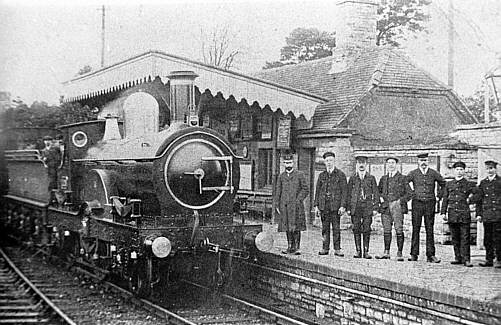 |
This fine Edwardian photograph shows the station staff at Witney posing by a spotless Great Western Railway 2-2-2 locomotive (possibly 'Sir Alexander' Class 1128), the station
master is on the left of the group. The Fairford Branch was the final home to these single wheelers, with the final example being withdrawn just prior to the First World War.
Stanley C. Jenkins Collection |
|
The East Gloucestershire Railway had initially been conceived as a cross country route linking Witney and Faringdon to Cheltenham via Andoversford, indeed earthworks were
already underway at Andoversford when the operation was scaled down to a purely local line from Witney to Fairford. In 1869 work commenced on this less ambitious plan, although the layout of the station at Fairford
clearly indicates that it was never intended as a terminus and that Cirencester and a connection with Midland & South Western Junction Railway was their ultimate aim. The line from Witney to Fairford opened on 14
January 1873 and the resultant 22 mile branch line was operated by the GWR until that company took over the two local companies entirely in 1890. |
|
A pair of trains cross at Witney in the Edwardian era. A 2-4-0 'Metro' tank is seen taking water whilst working an Oxford to Fairford train. These locomotives were synonymous
with the Fairford Line during the first half of the twentieth century, and the line was indeed their last stronghold. They were used on the line right up until 1949, when the last example, No. 3588 was withdrawn.
Stanley C. Jenkins Collection |
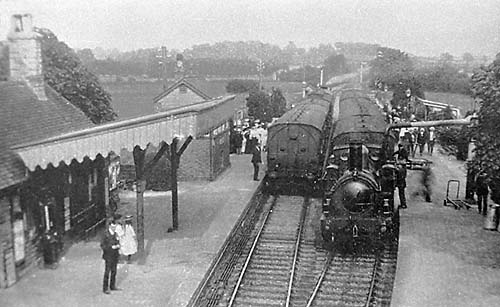 |
|
For the first half of the twentieth century the Fairford Branch like so many rural lines up and down the country continued to serve the local community with remarkably
little change in the pattern of services. The second world war did however bring an increase in traffic to the line and numerous track improvements were put in place to cater for the extra traffic. Aerodromes at
Fairford, Broadwell (near Alvescot), Brize Norton & Stanton Harcourt, as well as various army camps all ensured a large number of military personnel using the line. However, after the war, the increased use of road
haulage of goods and the ever increasing rise in the use of the private motor car saw traffic on the line reduce considerably. |
|
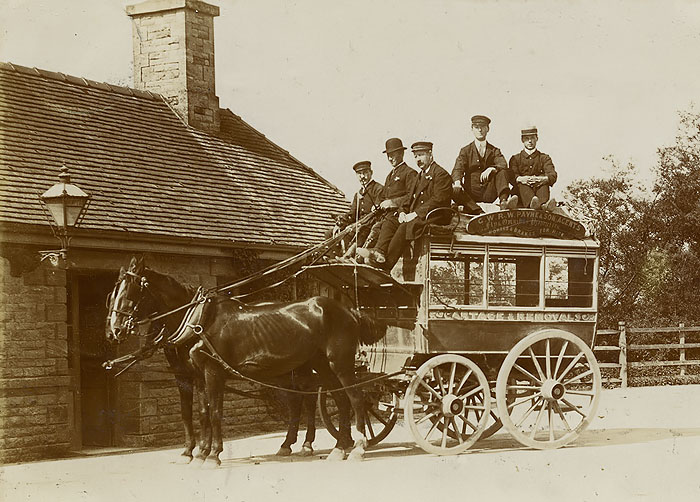
|
|
Now here is something a little out of the ordinary. A horse bus poses for the photographer at Bampton station in 1908. The board on the roof indicates that W. Payne &
Sons are operating the service on behalf of the GWR. Walter Frederick Payne is listed in Kelly's Directory as a carrier from Bridge Street, Bampton. The wording on this bus advertises fine omnibuses, horse and brakes for
hire, plus cartage and removals. There are plenty of staff in this view, yet no passengers, indicating this is a specially posed photograph, although presumably there was some local service operating at this time.
Incidentally, the horse looks a little undernourished! Integrated transport of a century ago! This view is also particularly interesting as it shows the eastern end of Bampton station building prior to the addition of a
parcels office during WW1, which completely altered this end of the building. The chimney seen here was replaced by one much lower down the roof on what is the very corner of the building in this view. The building was
considerably extended and lost its half-hipped roof.
Martin Loader Collection |
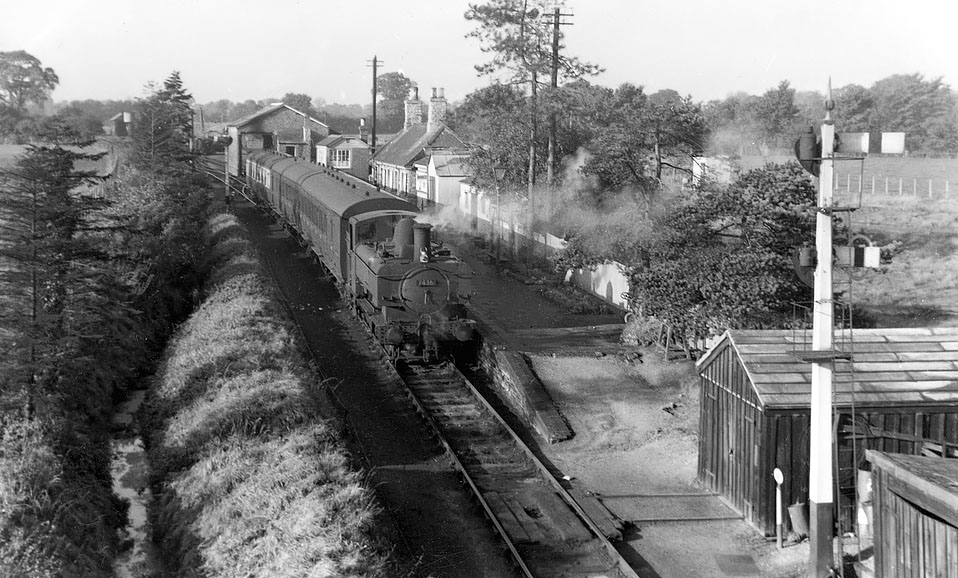 |
Fairford station, pictured during the Indian Summer of the line's existence, when the track layout at the stations were at their most extensive, but before the real rundown of
the train services. 74xx 0-6-0PT waits at Fairford station on 28 October 1954, ready to work the 09:15 service to Oxford.
Russell Leitch |
|
|
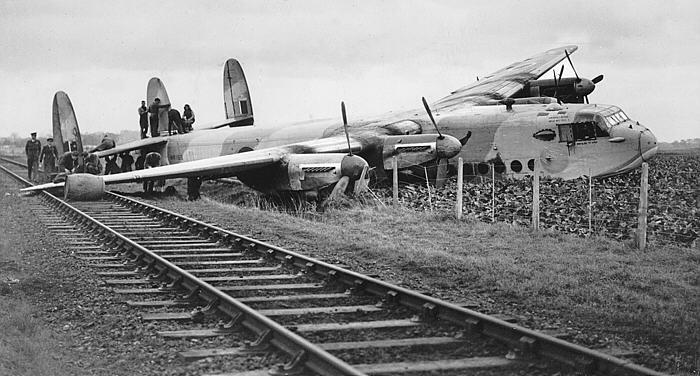
|
|
Oops! On 28 November 1946 an Avro York MW168 belonging to the Transport Command Development Unit at RAF Brize Norton failed to become airborne and instead crashed onto the
railway line between Brize Norton and Carterton stations, coming to rest in a field, as pictured above. Needless to say the line was closed for several days while the RAF effected recovery.
Martin Loader Collection |
|
A rare picture showing the interior of Witney station during the late 1950s / early 1960s. Note the amount of paperwork involved in the running of even a small station like
Witney.
Stanley C. Jenkins Collection
|
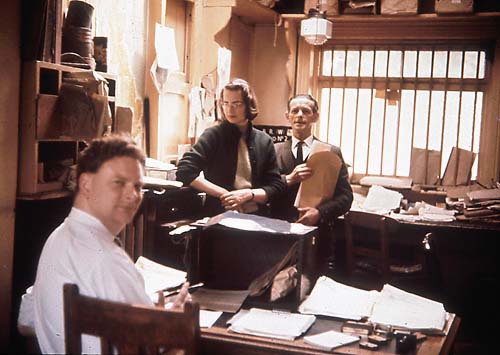
|
|
The reduction in traffic finally led to the Witney to Fairford section being closed to all traffic on 18 June 1962. This being a Monday, the last trains ran on Saturday 16
June 1962. As with other line closures, the trains on the last day were packed (I wish I could say "I know I was there" but although I did indeed travel from Carterton to Fairford and back, I was only four
years old at the time and cannot remember a thing about the day!). A freight service continued from Oxford to Witney until 2 November 1970. |
 |
Witney station master John Barnby shakes hands with the driver of the final steam locomotive to leave Witney on the evening of 30 December 1965. The driver was A. Johnson of
Oxford shed and the fireman was J. Compton. This was most unusually working by a 2-6-2T rather than one of the ubiquitous pannier tanks. The final steam hauled train on the Western Region ran just four days
later.
J. Barnby (Stanley C. Jenkins Collection) |
|
The diesel era commenced on the Witney branch on 3 January 1966, when North British Locomotive Company Class 22 diesel hydraulics started to work the thrice weekly freight.
Occasionally Class 08 diesel shunters substituted, but their 15mph top speed was a little limiting even for this backwater. The Class 22s performed well for the next five years, and like the Metro tanks before them,
found that this to be their last stamping ground. Of this small class of 58 locos, at least 13 individual locos are known to have worked to Witney. |
|
In the latter days of the Fairford Branch, during the freight only period, the line was worked as a long siding, obviating the need for any signally, once the train was locked
'inside' at Yarnton Junction. During this period, Class 22 diesel hydraulic 6326 is pictured crawling over South Leigh level crossing with a Witney to Hinksey freight. The secondman is seen climbing back into the cab after
opening the gates. As can be clearly seen here, one of the "gates" is in fact a length of rope - a makeshift replacement for one of the damaged originals. At this stage in the line's life no money was being spent
on renewals!
Stanley C. Jenkins |

|
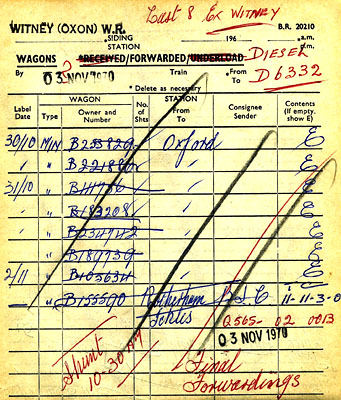 |
The line closed officially on Monday 2 November 1970, but as can be seen from the final page of the wagon forwarding book (left), it was the following day that Class 22 diesel
hydraulic D6332 collected the final eight wagons from Witney. Seven of the wagons were empty to Oxford, and one loaded to Rotherham.
Witney & District Museum
|
|